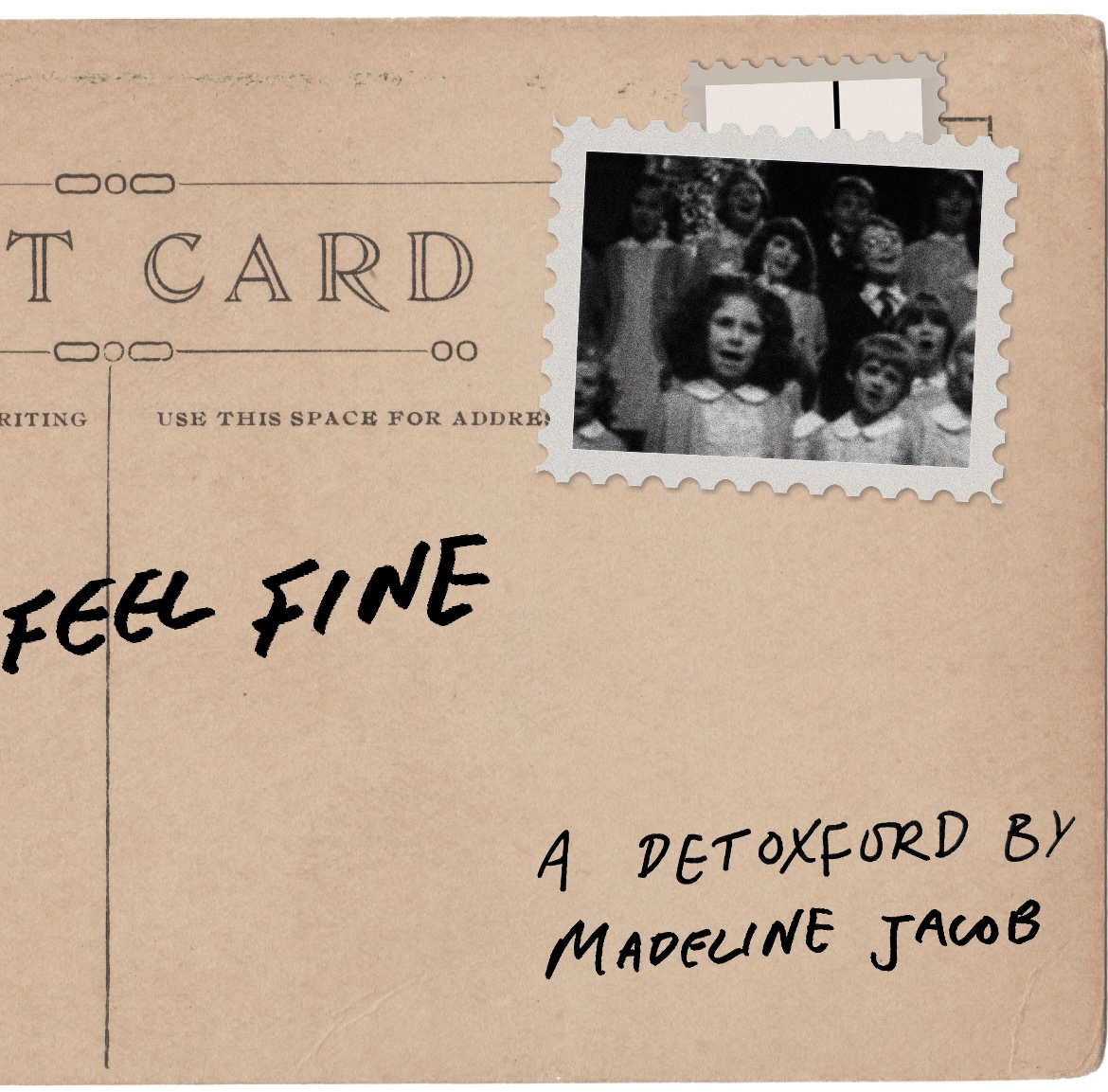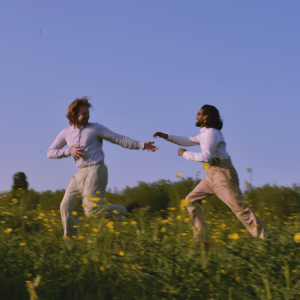Makes me feel fine
by Madeline Jacob | September 25, 2024
A search for out-of-print children’s choral covers of pop songs on the internet, and for the spirit of childhood, if such a thing can be said to exist.

I’m starting with a bona fide child I know in person. A few weeks ago, I stayed a night at my sister’s flat, and took her seven-year-old daughter’s bed as they were away on holiday, and my mum had taken my sister’s bed. In my niece’s bedroom, illuminated by the streetlamps outside and the glow-in-the-dark stick-on stars above me, I was visited by a strong—almost overwhelming—feeling of peace. Lying below the stickers and blooming felt-tip drawings on the bedframe, I felt as if my niece had curated this space just for me, to return momentarily to myself as I was thirteen years ago, a child.Such a feeling is of course a delusion, and a solipsistic one at that. On further reflection I would prefer to use that memoryof myself, however warped, to think imaginatively about my niece’s interior design. I remember feeling at times an alertness, as a child, to my own vulnerability, as a small, soft body in a razor-sharp world. In curating a space my niece hasmade a first step towards manipulating the space at hand to accommodate herself. The evidence: although the room’sidentikit pink and wobbly children’s furniture testifies to a flat-pack notion of ‘the child’, my niece has labelled her chest of drawers as ‘Cabint to pout clothes in’ in jagged black marker. Her bedside table displays a fold out photograph of my sister, her mother, with the bravado of a proud grandparent. I see in this a spirit of childhood unkempt and resistant, repurposing the shiny, mass-produced version for its own ends.
The first children’s choral cover to catch my attention was a cover of ‘Summer Breeze’ by Seals and Croft. I heard it on NTS radio and, swept up in its hum of multitudes, tracked down the record on YouTube. It had been digitised by a channel called Mystery Discs (after the Frank Zappa compilation CD album—part of a wave of faux-bootleg deep cut albums released in the late nineties). The channel Mystery Discs uploads digitised private press records—self-published vinyl produced in small numbers for largely non-commercial purposes. Since then, I’ve spent time each vacation trawlingthrough Mystery Discs’ uploads for more children’s choir covers. The person behind the account has no doubt been trawling through American thrift stores and vinyl bins in a similar manner. They and I have been afflicted with the same disease: nostalgia.
Hearing an alternative version of a pop song is highly pleasurable, hence the popularity of Like A Version, a video series where musicians cover songs for Australian radio station Triple J. There’s an aetiological tale about the origins of pop music which explains this. When music producers made their money from selling sheet music, professional song pluggers advertised the sheet music by singing it in public. Publishers bought tickets to events with big crowds: sports games, vaudeville shows, etcetera. Stationed in the crowd,pluggers would perform on repeat, until people leaving the shows would be singing the catchiest songs. The versions of the songs I found myself searching for, the songs children in the seventies whipped up into ornate choral delights, can find this search for a repeatable earworm in their genealogy. Pop is about the pleasure of repetition. Repetition transcends the material world and enters the dream-world where pattern holds its court.
Picture it: early August. Hit with a post-holiday malaise, I’m surfing the net, motionless, in my basement bedroom, curled around my phone with my headphones in. There are fewer really good children’s choir covers than you’d think. There are plenty of songs, ‘70s songs especially, which have children singing in them, but it’s as a kind of exaggerated effect. At that time, children’s voices represented the youth of the world, or the voice of change. In the classic Coca Cola advert, the ‘youth of the world’ sing ‘I’d like to buy the world a Coke,’ from the top of a Swiss mountain. The unified voices of children become the currency with which you signal your radical intent, even if you’re a multinational corporation. The children’s choir has room for a paradox: the child as a unique and individual entity, and their indiscriminating community spirit, innocent of worldly divisions.
The archetypal 1970s child is in some ways a descendant of the 1950s naughty schoolboy. Like Just William or Enid Blyton’s schoolgirls, they’re vagrant and muddy. But the 1970s schoolchild of Madness’ ‘Baggy Trousers’ and Pink Floyd is more deprived and more politically active. In early 1970s Britain, the National Union of Teachers went on strike to secure higher pay, leaving children to roam the country on Raleigh Choppers. School children were also militant, striking and occupying their schools over school closures and sometimes over racist police violence. There were children’s marches in south London organised in response to the imprisonment of the Brockwell Three in 1974. It makes sense that children’s voices appear in pop tracks seeking to imitate protest songs. Children’s choirs walk the line between the conformism of singing together and the radical possibilities ofcollective action. Or, at least, they invoke the aesthetics of radicalism. It’s the ironic thing about the kids in Pink Floyd’s‘Another Brick in the Wall Pt. 2’: that they sing their testament to free thought and individualism in unison.
I was in pursuit of more children’s choirs, though, bearing far less critical intent than I pretend to now. More than what seventies rock and rollers thought was radical, I wanted to hear children given the chance to sing what they enjoyed. On Spotify, I found a record by The Langley Schools Music Project – an assemblage of Canadian schools recording pop covers in the mid-1970s. It’s playtime stuff: Paul McCartney songs, The Beach Boys and David Bowie. They were found in a thrift store in 2000 and sent to Irwin Chusind. Chusind is a music journalist, and a proponent in the early 2000s of ‘outsider music’. His usual beat on the blogosphere was tofind ‘bad music’—naïve, amateur, DIY—and write about why its naivety could be enjoyable. Chusind eventually got the Langley Schools collection released as a CD called Innocence & Despair, and it made a big splash internationally as a cult record.
Innocence & Despair is frustratingly slow and quiet beside Mystery Discs’ star records, comprising in my opinion‘Summer Breeze’, ‘Got to Get You Into My Life’, ‘Spinning Wheel’ and ‘It’s Gotta Be Real’. And YouTube, which is more polyvocal than the 2000s blogosphere, has space for the past to resurface, for the child musician to grow up. ‘Oh-h Child’by Five Stairsteps was covered by the Immaculata Guitar Group from Marrero, Louisiana in 1976. One of the teenage bassists on the recording crops up in the comments section; she and Mystery Discs have a short discussion. She gives some details about the rushed recording process (‘what we played is what you got’) and about the record’s limited distribution. She asks Mystery Discs to continue uploading tracks from the record, but there’s no reply comment, and there aren’t any more on the YouTube channel. This is true ofmost of the tracks on Mystery Discs’ account—usually the only one uploaded from a vinyl in their collection. The time it takes to digitise and upload tracks partially explains why everything isn’t up there. Without wanting to speculate about Mystery Discs’ motivations, though, the carefully curated YouTube channel also reveals a culture of exclusivity and rarity around these out-of-print records in general.
While private press records are largely from the 1960s and 70s, they only became cult collectables in the early 1990s, gaining popularity in tandem with the trade in fan recordings of live concerts. Bootleg recordings hitched onto the early internet, and old, obscure recordings avoided the legal action that more contemporary ones were facing as the internet increasingly formalised. No one was interested in their copyright, or even knew they were entitled to it. So why hasn’t Mystery Discs uploaded the entirety of their record collection? Popular music scholar Tom McCourt suggested in 2005 (the height of MP3 music blogs and the craze for cult ‘outsider music’), that even though digital files don’t have materiality, they foster a sense of ownership and intimacy when we can easily store them and interact with them via our computer interfaces. I can’t explain why Mystery Discs isn’t uploading their whole collection, but I can notice in myself that when I found these covers online, I experienced a sense of pride. Like a metal detectorist finding a treasure on someone else’s land, I had found my own (immaterial)treasure to covet and enjoy without having any right to it. I was able to relive that very childlike experience of not owning what you enjoy, of wading in the muddy shallows of property and copyright law.
I want to bear in mind that emotions are relational, bringing together the histories of both subject and object in their interaction. Children’s choir records are charged with emotion. I can feel it through the recording, vibrating through time, through palimpsests of mediation (vinyl, CD, internet, earphones), into my mind. My sense of orientation is scrambled: I don’t know where to look for the meaning of these songs. I will try, here. If the process of growing up is about pushing your caregivers away and recognising your independence as a physical entity, then children’s choirs teeter on a knife-edge of individuation. They thrum with futurity, an energy that only comes when the desire to stay at home and the desire to leave and change are held in equilibrium.Children’s choirs frozen in time, archived on the internet, their members resurfacing as American boomers, testifies to the strange temporality of the internet. Out-of-print hoarder culture shows how even the most pleasurable and pointless activities are strung through with ideological commitments to property ownership and individualism. The children on these records sing with pleasure, their voices laden with affect: that group feeling which occurs at football matches and school assemblies. It has all the innocence of pleasure, but it’s vulnerable to exploitation. I have participated in the pleasureand danger of the earworm: alone, but connected, immaterially, to the youth of the world.
My collection of Children’s Choir Covers etcetera:
Greenbank Senior Public School – Spinning Wheel
https://youtu.be/jI2iFG8sZjU?si=H7IcJR2JUJGOoGWC
Les Petits Chanteurs d’Asnières sing a version of Serge Gainsbourg’s J’e suis venu te dire que je m’en vais to Serge Gainsbourg in 1988
https://youtu.be/unYu22Ign1E?si=evULP7hl_P1XR6Hi
Capital Children’s Choir singing Lily Allen’s Chinese in very clipped English accents
https://youtu.be/GZjcfZ2pWtM?si=I-gaKSrBIiraRzol
Immaculata Guitar Group – Oh-h Child
https://youtu.be/T01zrV_-7PI?si=4dARANMXYlB4UVLC
Randolph Macon Woman’s College – It’s Gotta Be Real
https://youtu.be/vT341qAwrWs?si=_Yve_crsYuWtpDET
Finn Hill Junior High Girls Choir – Got to Get You Into My Life
https://youtu.be/Ubqmm2q3xSo?si=mqQEAbT11leogyVW
La Mesa Junior High School Vocal Department – Summer Breeze
https://youtu.be/0kdt1GvQa0s?si=PgvZU9xNl1ozN5nj
Primghar High School Swing Choir – Celebrate
https://www.youtube.com/watch?v=9UeLVSQGG-o
The Golden Voices of Waco High School – The Beat Goes On
https://www.youtube.com/watch?v=7fqCQBZPawM
The Langley Schools Music Project – Space Oddity
https://youtu.be/YWjTbB4ONeM?si=KrRDnTbZi8ZT0X03
St Winifred’s School Choir – There’s No One Quite Like Grandma
https://youtu.be/rsXJcIODLtQ?si=iSVOjnDsF3lMV7je
This song unexpectedly beat John Lennon’s ‘(Just Like) Starting Over’ from Double Fantasy to the top of the Christmas 1980 charts.
John and Yoko’s ‘Happy Xmas (War is Over)’ with the Harlem Community Choir
https://youtu.be/yN4Uu0OlmTg?si=-ENLdSGQ8Xy8fxYD
One of the original protest songs to use children’s voices as social comment, which didn’t get a mention in the article due to its festive nature. It’s another song to be beaten by St Winifred’s School Choir in the Christmas 1980 charts.
Words by Madeleine Jacob. Image Courtesy of Alice Robey-Cave.




